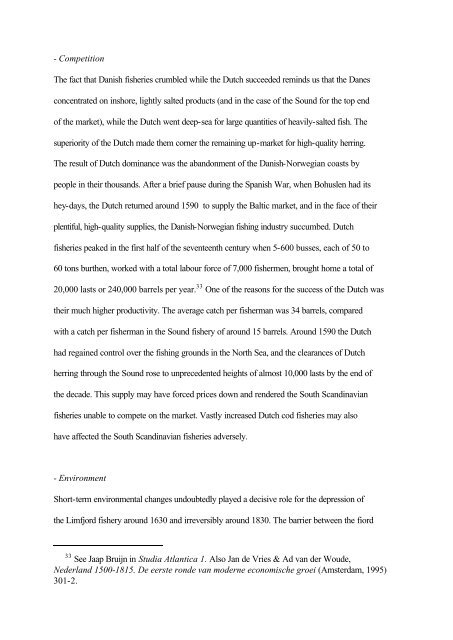The Danish fisheries c.1450-1800. Medieval and early modern ...
The Danish fisheries c.1450-1800. Medieval and early modern ...
The Danish fisheries c.1450-1800. Medieval and early modern ...
Create successful ePaper yourself
Turn your PDF publications into a flip-book with our unique Google optimized e-Paper software.
- Competition<br />
<strong>The</strong> fact that <strong>Danish</strong> <strong>fisheries</strong> crumbled while the Dutch succeeded reminds us that the Danes<br />
concentrated on inshore, lightly salted products (<strong>and</strong> in the case of the Sound for the top end<br />
of the market), while the Dutch went deep-sea for large quantities of heavily-salted fish. <strong>The</strong><br />
superiority of the Dutch made them corner the remaining up-market for high-quality herring.<br />
<strong>The</strong> result of Dutch dominance was the ab<strong>and</strong>onment of the <strong>Danish</strong>-Norwegian coasts by<br />
people in their thous<strong>and</strong>s. After a brief pause during the Spanish War, when Bohuslen had its<br />
hey-days, the Dutch returned around 1590 to supply the Baltic market, <strong>and</strong> in the face of their<br />
plentiful, high-quality supplies, the <strong>Danish</strong>-Norwegian fishing industry succumbed. Dutch<br />
<strong>fisheries</strong> peaked in the first half of the seventeenth century when 5-600 busses, each of 50 to<br />
60 tons burthen, worked with a total labour force of 7,000 fishermen, brought home a total of<br />
20,000 lasts or 240,000 barrels per year. 33 One of the reasons for the success of the Dutch was<br />
their much higher productivity. <strong>The</strong> average catch per fisherman was 34 barrels, compared<br />
with a catch per fisherman in the Sound fishery of around 15 barrels. Around 1590 the Dutch<br />
had regained control over the fishing grounds in the North Sea, <strong>and</strong> the clearances of Dutch<br />
herring through the Sound rose to unprecedented heights of almost 10,000 lasts by the end of<br />
the decade. This supply may have forced prices down <strong>and</strong> rendered the South Sc<strong>and</strong>inavian<br />
<strong>fisheries</strong> unable to compete on the market. Vastly increased Dutch cod <strong>fisheries</strong> may also<br />
have affected the South Sc<strong>and</strong>inavian <strong>fisheries</strong> adversely.<br />
- Environment<br />
Short-term environmental changes undoubtedly played a decisive role for the depression of<br />
the Limfjord fishery around 1630 <strong>and</strong> irreversibly around 1830. <strong>The</strong> barrier between the fiord<br />
33 See Jaap Bruijn in Studia Atlantica 1. Also Jan de Vries & Ad van der Woude,<br />
Nederl<strong>and</strong> 1500-1815. De eerste ronde van <strong>modern</strong>e economische groei (Amsterdam, 1995)<br />
301-2.






